8 Weapons-Grade Tricks That Boost Your Persuasive Copywriting Power

In marketing, the words you choose (and how you use them) determine how people respond to your content. Your words determine whether people read the entire landing page or blog, whether they act and fill out a form and ultimately, whether they choose to buy from you.
By now you’re probably thinking, “Great, no pressure or anything!” And I get it – choosing the right words sounds like a daunting task. But lucky for you, some words are more powerful and persuasive than others.
What you might be surprised to learn is that, for the most part, these “power words” don’t look so powerful at all. But don’t be fooled – this speaks to just how effective they are.
And while these words, phrases and copy constructs don’t guarantee someone will do what you want them to, it does increase the likelihood of success.
Let’s jump right in.
1. Understand (and use) the authority principle
Ever wondered why people generally respect figures of authority? Turns out, people are hard-wired to respect authority, which is what makes the authority principle such a powerful tool in marketing.
The science behind the authority principle tells us it’s important to show your audience what makes you a credible, knowledgeable authority before you make an attempt to sell your product or service. Of course, it’s easy for you to tell people how great you are, but that’s not what people care about. Instead, let other people do it for you in the form of testimonials or case studies.
In this example from Citrix, they use testimonials from well-known and respected corporations to show how effective their products are. Due to the authority these companies have – along with the word “expert” in the header – people are more likely to see Citrix as a trusted choice.
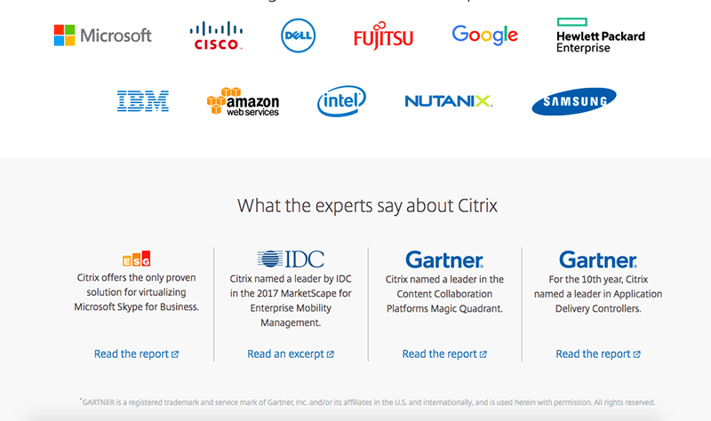
2. Harness the power of the word “because”
Getting people to do what you want – like download an e-book or sign up for an email newsletter – is often as simple as providing them with a reason. And Harvard University researcher Ellen Langer proved that one way to do this is to use the word “because.”
Langer conducted a study where she sent someone to the head of a line of people waiting to use a busy copy machine and had them use three different requests when trying to cut in line:
- “Excuse me, I have five pages. May I use the Xerox machine?”
In this scenario, 60% of people allowed the person to cut in line and use the copy machine first.
- “Excuse me, I have five pages. May I use the Xerox machine because I am in a rush?”
This time, the message was tweaked by adding the word “because” followed by a simple reason. It was a seemingly small change, but 94% of people allowed the person to cut in line. - “Excuse me, I have five pages. May I use the Xerox machine because I have to make copies?”
In the last scenario, the person went from having a passable reason for cutting in line (“because I’m in a rush”) to no reason at all (doesn’t everyone in line need to make copies?). And yet 93% of people let the person cut in line – a one percent drop from the second test and a 33% improvement over the first.
Langer’s research identified the word “because” as a compliance trigger. When we hear the word “because,” we automatically start to agree without fully processing what comes next. We just assume there’s a logical, rational reason for the request.
Take HubSpot, for example. In many of the emails they send, HubSpot includes a short reason why you’re receiving that email. It’s nothing earth-shattering, but it works (especially if you’re like me and forgot why you’re getting these emails in the first place).
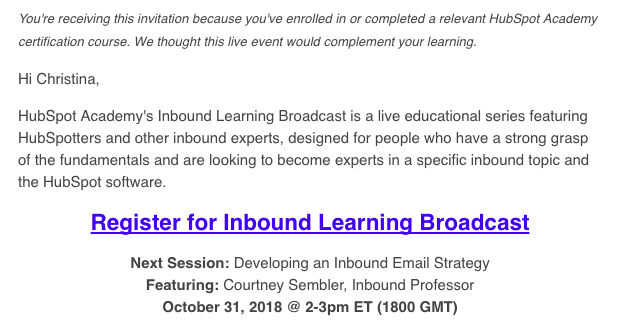
If you’re not doing so already, take advantage of the surprising power of the word “because” in your marketing. And remember: Your reason why doesn’t have to be perfect. Even giving a weak reason is more persuasive than giving no reason at all.
3. Create a sense of urgency
People often want what they can’t have. And when things are readily available to us, we tend to want them less. In fact, social scientists have proven that we place greater value on things that are scarce, leading to what’s known as the scarcity principle.
There are two elements that make up the scarcity principle: urgency and exclusivity.
To trigger urgency, use phrases such as:
- Now
- Minutes
- Limited time
- Today only
- Last chance
- Only X number remaining
- Dates and deadlines
To trigger exclusivity, choose phrases like:
- Exclusive
- Only for [group descriptor]
- Just for you
- Be the first
- Before anyone else
Bath & Body Works does a great job at creating a sense of urgency in their email marketing. Just take the email below as an example:
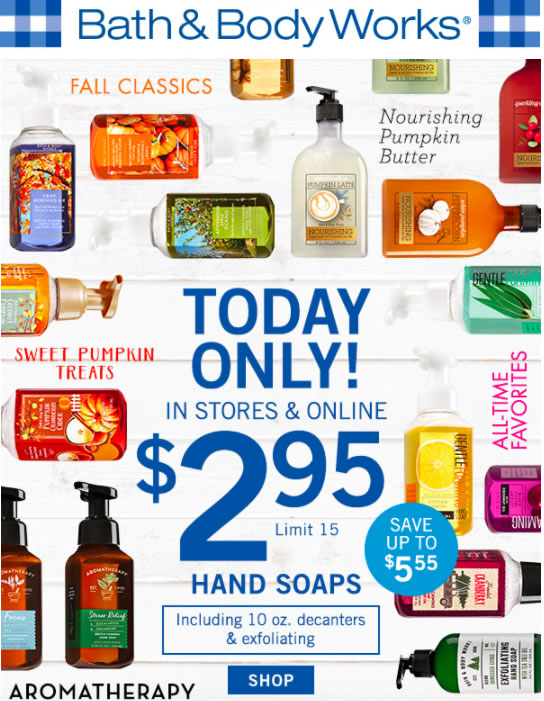
4. Give your customers a guarantee
One of the biggest reasons people don’t buy your product or service is because they don’t like taking risks – especially when money is involved. Even before buying, consumers think, “What will I lose if this doesn’t work out?”
Offering a guarantee for your product or service is one of the most effective ways to sway a risk-averse consumer because it removes the risk involved with buying.
L.L. Bean gets it, and they’re a great example of a company that gives their customers a 100% satisfaction guarantee on all products. And their guarantee is simple: If something doesn’t fit, work right or last as long as it should, you get your money back – regardless of how long you’ve had it. With a guarantee like that, who could worry about taking a risk and making a purchase?
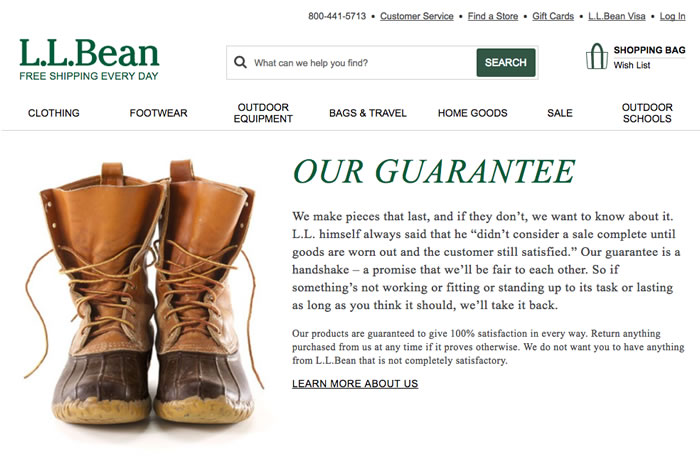
5. Discover the allure of the word “new”
Social scientists have found humans crave things that are new and novel. And when we find something new, it activates the pleasure center in our brains, which feels good. As a result, it sends us looking for the next new thing.
As a marketer, you can always count on the word “new” to attract attention and persuade people to take the next step. The best way to do this is to place the word “new” in highly read areas of your copy such as headlines, subject lines and captions.
But you’re not just limited to the word “new.” Other words in the same family include:
- Now
- Announcing
- Introducing
- Finally
- Soon
And if you’re in need of a verb, consider the word “discover” as it hints at something being new – and it feels like much less work to your audience than the word “learn.”
Sephora is great at using the word “new” to attract attention and encourage sales. They frequently send out emails featuring the newest products at Sephora that month and take it a step further by encouraging you to be the first to own these new arrivals.
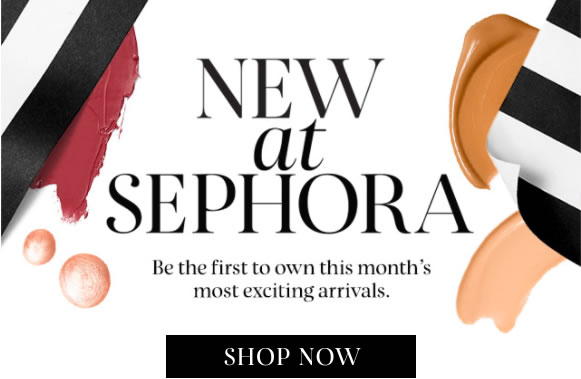
6. Include personalization whenever possible
Marketers have been talking about the importance of personalization for years. And it’s for a good reason: Data shows it makes a difference.
A study by Experian showed personalized emails generate six times higher transaction rates than emails that aren’t personalized. And Janrain found companies that personalized their web experience for visitors saw an 18% increase in sales.
Personalize your marketing whenever it makes sense – like in subject lines, body copy or graphics. But don’t think you’re just limited to using a person’s name. You can personalize your marketing with a person’s job, location, pain points, buying habits and more. Just don’t be creepy about it, okay?
Fitbit is one example of a company that does personalization well. Every week, I get a progress report that’s personalized with my name, picture and data, which is exactly what I’d expect to see with this type of email.
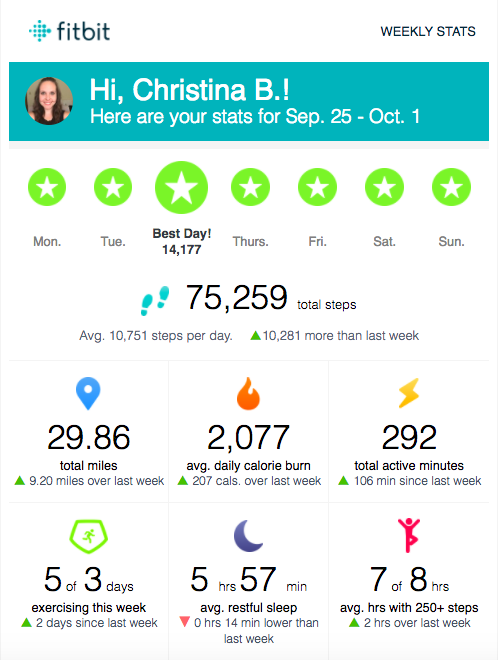
7. Tell a story to your audience
Long before the written word, stories were how information was transferred from person to person and generation to generation. Fast forward to today, and science can explain why stories are so effective.
When people deal with facts and figures, it activates the parts of the brain where language is processed. But when we read or hear a story, something else happens.
Stories about someone taking action activates the brain’s motor cortex. Stories about how something smells activates the olfactory cortex. And stories about how something feels activates the sensory cortex.
Why is this important? Well, neuroscientists have found the more parts of your brain are activated, the better you understand and remember information.
And when it comes to your marketing, that’s exactly what you want – for people to remember you. Stories add value to a product or service and help you connect with your audience. And in a world with so much content, stories are memorable and allow you to stand out from your competition.
Take High Brew Coffee, for example. Instead of just writing a simple “about us” section like many companies, they use copy and video to create a story that’s both memorable and different.
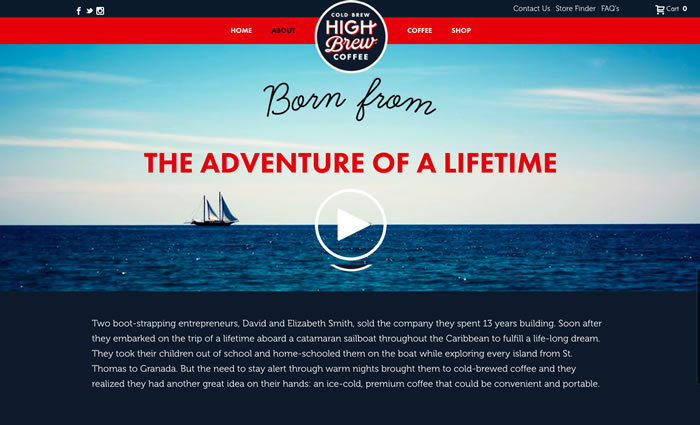
Related Content: Brand Storytelling: How Fiction Bestsellers Add Sizzle to Stories
8. Change your reader’s perspective
Framing is a powerful tool for marketers. The words you use and the order in which you use them make a huge difference in terms of how your readers perceive and respond to your message.
When you need to write copy that persuades and encourages visitors to take a specific action, frame your message in a way that’s most beneficial to you.
Take this exit popup from IMPACT Branding & Design. Instead of just having the “get it now” CTA along with an exit button in the corner, visitors must click the button that reads “No thanks, I don’t want the essentials” if they want to leave the page.
This is effective because, as humans, we don’t like saying “no” to someone or something – even if it’s free. By framing the consequences of not saying yes – which in this case is not learning the how to master the essentials of an inbound marketing website – IMPACT taps into their visitor’s emotions, encourages more people to download the offer and in turn, increases conversions.
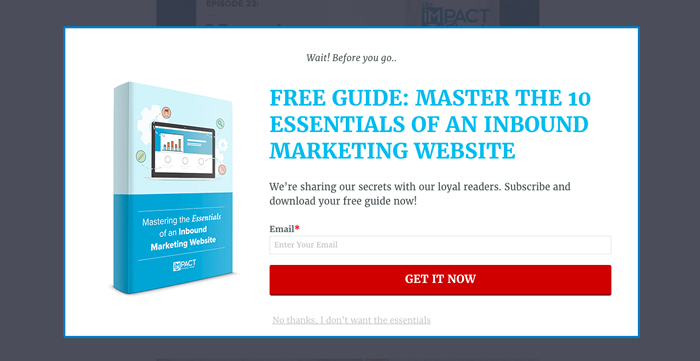
As you set out to write more persuasive content, it’s important to choose your words carefully. Not every copy construct listed above will work for your writing. Instead, choose the words and phrases that are most likely to prompt the response you seek.
Ready to turn these copy constructs into some seriously persuasive copy on your blog? Download our Persuasive Copywriting Guide to help you make it happen!





